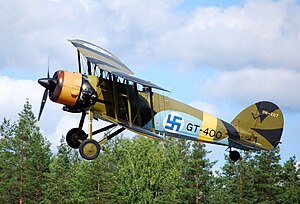Gloster Gauntlet
| Gauntlet | |
|---|---|
 |
|
| An ex-Finnish Air Force Gloster Gauntlet Mk II, GT-400, taking off at Selänpää Airfield | |
| Role | Fighter |
| National origin | United Kingdom |
| Manufacturer | Gloster Aircraft |
| First flight | 1933 |
| Introduction | 1935 |
| Retired | 1943 |
| Primary users |
Royal Air Force Finland Denmark |
| Produced | 1933–1936 |
| Number built | 246 |
| Developed from | Gloster S.S.19B |
| Variants | Gloster Gladiator |
The Gloster Gauntlet was a British single-seat biplane fighter of the RAF, designed and built by Gloster Aircraft in the 1930s. It was the last RAF fighter to have an open cockpit and the penultimate biplane fighter in service.
The Gloster S.S.18 first flew in January 1929. The Gauntlet was a development of the Gloster S.S.19B design, which originally mounted six machine guns (four in the wings and two in the fuselage), the original S.S.19 prototype being re-engined with a Bristol Mercury VIs engine, first flying in this form in 1933. On testing the S.S.19, the Air Ministry placed an order for 24 aircraft in September 1933, to be named Gauntlet.
The order was followed up with more for the revised Gauntlet Mk. II. This new model used a revised construction method based on that used by Hawker following Hawker's takeover of Gloster, as this was much easier to build and repair than Gloster's welded structure. A total of 204 Mk IIs were produced in the UK.
The Gauntlet Mk. I first entered service with No 19 Squadron at RAF Duxford in May 1935. The Gauntlet proved successful and popular in operational service, being 56 mph (90 km/h) faster than the aircraft it replaced, the Bristol Bulldog to form the main part of the RAF's fighter strength. The Gauntlet was the fastest aircraft in the RAF from 1935 to 1937.
The Gauntlet Mk II entered service with 56 Squadron and 111 Squadron in May 1936, a further six squadrons being re-equipped with the Gauntlet by the end of the year. At the height of its career, the Gauntlet equipped a total of 14 Squadrons of RAF Fighter Command.No. 32 (The Royal) Squadron RAF Gauntlets were used in early trials of ground direction of fighters by radar.
As more advanced fighters, such as the Gloster Gladiator, Hawker Hurricane and Supermarine Spitfire started to re-equip the Gauntlet squadrons in 1936 and 1937, the Gauntlets were passed on to freshly formed units as their first equipment to allow then to gain training before receiving more modern fighters. Gauntlets were also shipped to the Middle East, equipping three RAF squadrons.
...
Wikipedia
